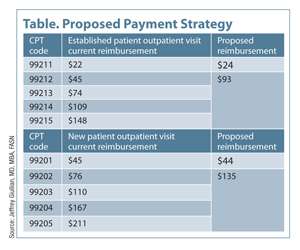The impact of proposed evaluation and management code changes for nephrologists
Click Here to Manage Email Alerts
One year ago, CMS administrator Seema Verma announced the launch of the agency’s new Patients over Paperwork Initiative. This commendable effort established listening sessions, customer-centered workgroups and mapped a course to reduce regulatory burden, improve the logic of outcomes measures, enhance patient access to their own data and simplify documentation requirements. Their laudable goal is “reducing administrative burden while improving care coordination, health outcomes and patients’ ability to make decisions about their own care.”1
With this backdrop, CMS suggested a new payment schedule for outpatient clinic visits to begin in 2019. Published in the July 27, 2018 volume of The Federal Register, the new physician fee schedule proposes to uncouple payment for outpatient new visits (CPT codes 99201 to 99205) and follow-up visits (99211 to 99215) from the traditional resource-based relative value system and collapse payments from five levels for each set of codes down to two levels.
On the surface, this proposal has some merit. By streamlining documentation requirements, removing antiquated 1995 and 1997 guidelines, and reducing redundancy in physician notes, the CMS goal is to improve the clarity of medical records which would only require pertinent facts, findings and observations.

While it is difficult to argue the virtues of such a change, the current proposal is likely to increase burden in the short run, reduce reimbursement for nephrologists, shift revenue to certain stakeholders and decrease physician ability to spend quality time with complex patients. In short order, this new fee structure will reduce nephrologists’ ability to run an efficient outpatient clinic. The unintended consequences could be fewer patients with chronic kidney disease cared for by nephrologists, earlier transition to dialysis and higher hospitalization rates.
Specifically, the proposed rule offers a blended rate for level 2 to 5 visits – $93 for established patients and $135 for new patients. For established patients, that blended rate is approximately half way between the current rates for a level 3 and level 4 visit and a bit closer to a level 2 visit payment than a level 5 payment. For new patients, however, the blended rate is closer to the level 2 and 3 visits compared to level 4 and 5 visits (see Table).2
To make up for this apparent shortfall, CMS has offered extra payments via add-on CPT codes for certain types of physicians. Via code GPC1X, primary care services would be eligible for an extra $5 per visit and code GCG0X would provide an extra $14 per visit to certain specialists. Unfortunately, nephrologists are not included in the category of physicians that qualify for the add-on revenue.

Theoretically, if a physician currently provides mostly level 3 and 4 visits and an equal number of both, they are not likely to see much impact of this payment change. Appropriately, however, nephrologists provide most visits at the level 4 or 5 rate. Patients with CKD tend to be clinically complicated, have multiple comorbidities, are cared for by several physicians and require appropriate office time to properly address their clinical and psychosocial needs.
In 2016, the most recent year for which claims data is available, nephrologists billing patterns would require a blended rate of $102 for established patients and $169 for new patients – 10% to 25% higher than the proposed rates for 2019.
While CMS’ mathematical models anticipate a less than 3% decline in payment for nephrologists,3 an independent analysis by the AMA, confirms a larger magnitude of revenue loss, likely around 13%.4
Financial loss of this degree is likely to impact day- to-day operations of nephrology practices and could lead to fewer patients receiving optimal outpatient care. One could easily anticipate that patients with multiple medical problems would require a greater number of visits, be sent to the emergency room more frequently or even start dialysis sooner —none of which are optimal for patients or the health care system as a whole.
Additionally, there is no guarantee, nor is it likely, that commercial payers would follow suit in 2019. In that scenario, physicians would ultimately have two separate systems for patient visits, documentation, coding and billing. This situation would paradoxically increase administrative burden on physicians and practices, the exact opposite intent of Verma and her colleagues.
The final physician fee schedule rule is due out in early November. Several vocal stakeholders, such as the Renal Physicians Association, AMA and others have provided valuable input to CMS, including requesting a delay in implementation, reconsideration of nephrologists as part of the cohort to qualify for the add-on payment and commitments to avoid revenue shifting from one specialty to another.5
In all, the CMS intent is a good one. It is physician-centric, which in turn could benefit patients. It also begins to reshape the focus of outpatient visits back to care and planning for the patient, as opposed to documentation for the sake of regulatory requirements. However, it is an idea in its infancy and will require more time, stakeholder input and analysis before it is truly ready for implementation.
- References:
- 1. www.cms.gov/newsroom/press-releases/cms-proposes-historic-changes-modernize-medicare-and-restore-doctor-patient-relationship
- 2. Table adapted from slide 10 of CMS’ Calendar Year (CY) 2019 Medicare Physician Fee Schedule (PFS) Proposed Rule. www.cms.gov/about-CMS/story-page/2019-Medicare-PFS-proposed-rule-slides.pdf
- 3. www.ama-assn.org/ama-offers-comments-cms-its-2019-medicare-reform-proposal
- 4. www.ama-assn.org/sites/default/files/media-browser/.../qpp-rule-summary.pdf
- 5. www.healio.com/nephrology/policy-and-politics/news/online/ %7B422ffc7c-e012-4ef7-9634-3cf17089c0a3%7D/coalition-asks-cms-to-reconsider-changes-to-evaluation-and-management-codes
- For more information:
- Jeffrey Giullian, MD, MBA, FASN, is a nephrologist from Denver and a Nephrology News & Issues Editorial Advisory Board Member. Disclosure: Giullian reports no relevant financial disclosures.
